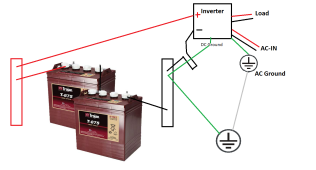
I don't have a metal battery enclosure, so the only thing I have to ground on the DC side is the inverter itself. The designated AC ground is properly connected to the sub panel -> main panel (where neutral is bonded to ground).
I will bond the two earth points as the instructions require, but do I really need to run a ground bus bar from my negative bus bar (creating the DC ground/neutral bond) if the only thing I have to ground on the DC side is the inverter itself? Seems like I could run straight from the designated DC ground on the inverter to the negative bus bar itself - which in turn would go to the GE/earth. I would still only have a ground/neutral bond in one place - because there's nothing else to ground - right?
My setup has been running fine for years, but I'm learning I should not have a 48V system floating. I'm more confused on this grounding issue than anything I ever ran into on the system otherwise.



